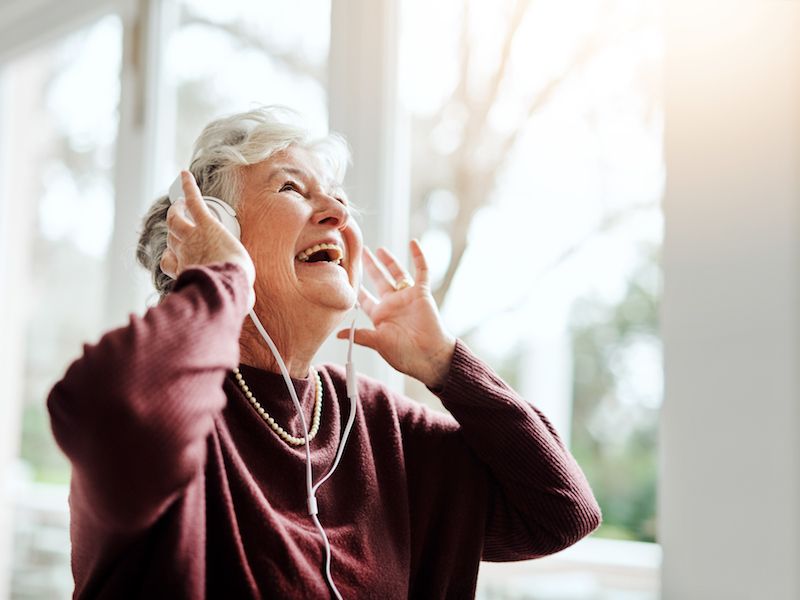
Individuals who work in loud surroundings like construction sites or at heavy metal concerts are not the only people affected by noise related loss of hearing. Leisure related noise exposure can be just as harmful as work related noise exposure. The most common kind? Music, gaming, streaming video or anything else that you would listen to through headphones or earbuds.
You might be surprised to discover that a mobile device can get that loud. But these devices can achieve continuous volumes of over 105 dB, which is close to the ordinary human pain threshold. This is the volume at which noise starts to literally hurt your ears. So what’s the plan to protect against this kind of noise-related hearing loss?
It’s important here to consider the volume. Listen with the volume at no more than 60% for no more than 60 minutes at a stretch (how long you listen for also matters), this is called the 60/60 rule.
Your Hearing Aids Can be Set up For Listening to Music
If you wear hearing aids, you’re more than likely streaming your mobile device right to your hearing aids, so be certain the volume is not too loud or that you’re not attempting to drown out other sounds with your music. In addition, ask us about how best to listen to music. If you’re a musician or someone who loves music you might have noticed that most hearing aids are programmed to sharpen the quality of voices…not necessarily music. We may be able to make adjustments to minimize feedback and noise while maximizing some frequency ranges to improve the quality of sound while listening to music.
Picking out Headphones
When picking out headphones there are numerous options, particularly if you wear hearing aids. It might be a matter of personal choice, but there are some things you should think about there as well.
Over-the-Ear Headphones
Over the ear headphones are becoming popular again but you probably won’t see the old foam covered speakers that once came with a walkman. Often surprisingly pricey, they feature a large variety of color choices and celebrity endorsements, and of course, exceptional sound quality. And unlike those little foam pads, these cover the whole ear, stopping outside sounds.
Conventional perception is that these are less dangerous than in-ear headphones because the source of the sound is further from your eardrum. But the reality is they’re often able to reach louder volume than their smaller kin, the speakers are much larger. Noise cancellation can be a helpful thing as long as you’re not missing out on needed sounds like an oncoming car or truck. But on the positive side, you won’t need to compete with outside noise so you can enjoy your music at lower volumes.
Earbuds
The normal earbuds are well known for poor sound quality, although a lot of people still use them because hey, they came with the phone. Specifically, with newer Apple phones, it’s just easier to use the earbuds which came with the device because it most likely won’t have a headphone jack.
The downside, besides the inferior sound quality, is that basic earbuds can’t cancel outside noises, so you’re more likely to pump up the volume. It’s commonly assumed that placing earbuds so close to your eardrum is the primary issue but it’s really the volume.
Earbuds That Block External Noise
More comfortable than standard earbuds, models with a round rubber tip are the choice of many because they help block outside noise. A seal that stops outside noise from getting in is formed by the rubber tip which conforms to the shape of the ear. Not to sound like a broken record, but these types of earbuds have the same disadvantages as the other two (it’s all about the volume), as well as carrying the same caution as over-the-ear headphones (they can block out warning sounds). Obviously, these won’t work for you if you use hearing aids.
A number of pairs might have to be evaluated before you find headphones that work for you. Your expectations, acoustically, will vary depending on what type of use you normally give them. The significant thing is to find headphones that make it comfortable for you to enjoy at a safe volume.
How to be Sure Your Hearing is Protected
Is it Safe, How Can I be certain? There’s an app for that…If you have a smartphone, you can download the National Institute for Occupational Safety and Health’s free Sound Level Meter app. You can get other apps, but research has discovered that the accuracy of these other apps is spotty (additionally, for unknown reasons, Android-based apps have been shown to be less accurate). That motivated NIOSH to create their own app. You can measure outside sounds with the app, but you can also measure the sound coming from your device’s speakers, essentially, the actual volume of what’s going to your ears. It’s a little bit of work, but taking these kinds of preventative steps can help safeguard your hearing.
